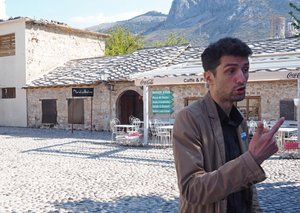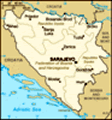Advertisement
Published: April 26th 2020

 Our guide, Boris
Our guide, Boris
In the background, a rebuilt slate roof, post-warWe had a leisurely breakfast this morning (cold cuts, cheese, fresh bread, banana), although I left early to write sketchy travel notes. This tour is so full, I can’t record it all before the next day. Not a bad thing.
Our guide, Boris, met us at our
Villa Fortuna Hotel. Immediately obvious was his deep knowledge of the centuries of history in Bosnia and Herzegovina (the country’s full name). Later we learned that he is a government archivist, as well as a tour guide. His mordant sense of humour lightened the essentially horrific two thousand years of conquests and wars in the area. Thankfully, he explained why this land has suffered so much turmoil. When the Christian church
split into Catholic and Orthodox, this land was on the dividing line, always a guarantee of tension. Essentially, the Croatians (inhabiting the Adriatic coast) became Catholic, the Serbs became Orthodox, and much later when the
Ottoman Empire conquered all of the area, the Bosniaks became Muslim. Every empire and aggressive country conquered some or all of the territory, creating many sub-groups. Add to this communications hampered by mountainous terrain, and cooperative federal government may be out of the question.
We walked along the streets coming awake for business.

 Surrounds of the Old Bridge
Surrounds of the Old Bridge
Imagine hills filled with implements of warIn the old city centre, tourism flourished with souvenir stores enticing customers. The high, curved
Stari Most (Old Bridge) is an icon for Mostar. Controversially destroyed during the 1993-1994 siege, it was rebuilt in the same configuration as in the 16 century. Access is by a stone pathway, highly polished by foot traffic. Helpful cross-ways ridges at regular intervals prevented too much slipping as we moved up the steep curve to the top. Everyone wanted a picture from the top, as did we, of the calm
Neretva River flowing through the press of houses, businesses and restaurants below.
Across the bridge was pure tourism, stalls and shops full of ceramics, decorative glass, t-shirts, brass vessels, carvings and on and on. Following Boris, we pushed our way through happy shoppers to find ourselves in an oasis - small quiet mosque. Allowed to enter and stand near the door, we absorbed the silence in the modest room. Intricate designs painted on the walls focused attention on the contemplative purpose for the space.
Boris led us to the enclosed court-yard of an estate house that is now a museum restored with the many carpets that were furnishings in the past. Bosnian carpets are

 Koski Mehmed Pasha Mosque 1618
Koski Mehmed Pasha Mosque 1618
Simply furnished and peacefulbright, bold and graphic in comparison to the more subdued, detailed patterns of Persian carpets. Seated on low couches, we were served
Bosnian coffee, which is boiled in a special small metal pot and served with sugar. Boris talked about the history of the house and its family, and how all the rooms were used. The coffee room was for their frequent family gatherings. Upstairs were a meeting/entertaining room for men and another one for women. These had views of the river and the city from a height equivalent to the bridge, because the house was built on stilts out from the face of the cliff.
Back on the main street and near to the house, we delighted in seating on a terrace for our lunch: chicken breast, lots of salad, fries, fresh bread cut in triangles, and baked apple with ground nut filling.
Driving up into the hills, we visited
Blagaj Monastery (from 1520) where (not-whirling) Dervishes have a religious retreat. As we walked along the path from the parking lot, all the tourists were marveling at the roaring river in full flood. On the other side of the river, plastic chairs and metal tables floated on the terraces

 Blagaj Tekke, Dervish retreat
Blagaj Tekke, Dervish retreat
Built at the headwaters of the Buna Riverof the cafés, and mallard ducks quacked in the eddies created by the terraces. Right under the Monastery, a great gush of water spewed out of the rock – the headwater of the
Buna River As an active place of contemplation and worship, the Monastery was quiet despite the many people touring. We removed our shoes and followed a local guide, seemingly a monk. The prayer rooms for the men and for the women were quite similar. The furnishings were low couches, covered tables and cushions. The floors were covered thickly in Persian and Bosnian rugs. Unfortunately, no one weaves Bosnian rugs now, even though they are striking and beautiful.
Walking back along the river bank, I was idly looking at the souvenir stalls. Suddenly, I was calling to Elizabeth to come and see the beautiful scarves. She didn’t hear me. Seduced by the first scarf/shawl, I bought it for 5€. Labelled as pure
pashmina I doubted it until trying the test – passing it through a ring without trouble. Manka was most jealous of such a pretty and low cost find.
Later, during our free time in Mostar, Elizabeth and I walked along the usual route back

 Karadjoz Mosque 1557
Karadjoz Mosque 1557
Central Mosque in Mostarto the tourist streets on either side of the bridge. In our three passages previously, there had been an elderly woman selling crochet, including a tablecloth. Ever since seeing a crochet shop in India and failing to buy a crocheted table cloth, I regretted my restraint. Now it looked like restraint was going to be forced on me, because it was wet enough and late enough that the woman had probably gone home. (Luckily today rain fell only while we were in the bus, with the exception of light showers.)
Walking beyond the concentration of tourist shops on the far side of the river, we passed the
Central Mosque of Mostar, dating from 1557. Although I did take a couple of photos, we didn’t want to explore or stare, as it may not have been meant as a tourist attraction. Without a guide, this was hard to judge.
Not much further on, we did find a shop filled with crochet, lace,
cutwork and other fabric arts. An opportunity not to be missed! Fairly soon I saw a round tablecloth suited to the size of my table, and then I saw a rectangular one. An embarrassment of riches! The friendly

 Lejda, owner of the fabric arts store
Lejda, owner of the fabric arts store
A shop of wonders in women's artistic workyoung sales woman brought them forward, as well as another that was crochet and fabric. Realizing I would buy one, she tried very hard to get me to take two at a very good price. Conscious of my two rugs, I knew my luggage wouldn’t stretch any further. As we concluded, she told me that her mother, Senada, had done the crochet. Very pleased, on our way back from our walk as we passed by the shop again, I asked to take her photo and asked her name - Lejda
For dinner we walked through the almost familiar streets to an extraordinary
restaurant that was built in layers down the cliff by the roaring
Radobolja River near the Stari Most. As always, the meal started with a soup, this time beef, and a mixed salad, followed by platters of roasted lamb, veal and potatoes. The dessert was a traditional fig cake soaked in honey with hint of chocolate – very dense, and not to everyone’s liking. I couldn't decide.
View map of trip to date.
Advertisement
Tot: 1.065s; Tpl: 0.019s; cc: 27; qc: 122; dbt: 0.6654s; 1; m:domysql w:travelblog (10.17.0.13); sld: 1;
; mem: 1.5mb























Isabel Gibson
non-member comment
Exotic
The markets, the decorative bits on the building exteriors, the shape of the windows, the stone patio/yard, and the use and colours of the textiles - highly distinctive, even exotic. Were you as much taller in that environment as the photo with Lejda would suggest, or was she just short? I'm so glad they rebuilt that old bridge in its original style, although the one from 1913 is attractive too. As for shopping restraint, some are born to it; some have it thrust upon them; and some are saved from it. How delightful to meet the artist's daughter.